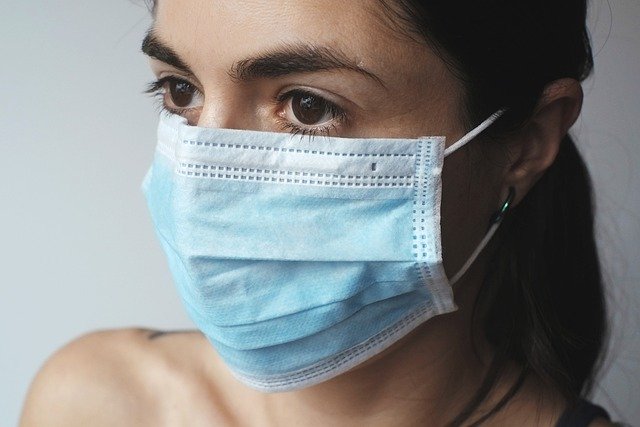Did you know that every month, the world needs 89 million medical masks, 76 million examination gloves and 1.6 million protective goggles for the Covid-19 medical response? (WHO projection 3 March).
According to an analysis by scientists at University College London, if every one of the United Kingdom’s 67.9 million population (Malaysia 32.7 million) used one single-use mask a day, for a year, an extra 66,000 tonnes of contaminated plastic waste would be created, with 10 times more climate change impact than using reusable masks.
Single-use masks are made from polypropylene (PP), a fossil fuel-derived plastic that takes hundreds of years to break down. PP masks are now the new litter finding its way into the oceans where marine life might mistake them for food.
“We’ve seen whales and dolphins washing up with plastic bags inside their guts,” says Gary Stokes, co-founder of Oceans Asia. “A similar thing could happen with these masks. They also shed tiny harmful microplastics into waterways, which may be consumed by unsuspecting fish and us.”
Single-Use Masks And Polymer Gloves Cannot Be Recycled
Latex disposable gloves are biodegradable, but those made from synthetic polymers (e.g. nitrile and vinyl) are not. The non-woven melt-blown polymer, most commonly PP, effectively blocks microbes and droplets and is widely used in surgical masks and protective clothing for health care workers. Medical disposables, for example pill casings, syringes, catheters and blood bags are made of synthetic polymers, for example polyvinyl chloride and PP.
Recycling is a challenge because “virgin plastic” is so cheaply available. “PPE (personal protective equipment) is made from a complex mix of materials that require specific machinery and techniques to recycle,” comments Stephen Clarke, head of communications at TerraCycle Europe. “It costs more to collect, separate and recycle the PPE than the value of the resulting recycled material. If the economics do not work, authorities do not have the incentive to collect and recycle PPE.”
Medics are not the only ones contributing to the growing mountains of plastic waste. Partners in crime include: people who wear disposable polyethylene (same polymer used for plastic shopping bags) gloves to avoid touching surfaces when they go shopping; and increasing food takeaways or deliveries in disposable meal boxes (PP or polystyrene).
Environmentally Friendly Face Masks – New Innovations
A Vietnamese Company, ShoeX, created the world’s first biodegradable coffee face mask, AirX, which is available online for USD19/ pack of five (several designs and colours).
AirX face masks offer 99.99% dual antibacterial technology with two layers of protection. The first layer is woven from coffee yarn using PowerKnit technology and provides a comfortable fit for sensitive skin. The mask has a biodegradable filter inside developed by silver nanotechnology and coffee. It is washable and reusable. Its filter does not need to be washed and lasts for 30 days. The mask has a natural coffee aroma and offers UV Ray protection.
AirX has obtained the AATCC 100 certification, the textile industry’s standard for antimicrobial fabric performance in the USA. This product is a more sustainable alternative to medical-grade masks. AirX can supply 10,000 masks per day to keep up with global demand. Founded in 2019, ShoeX is a Vietnamese-Canadian footwear company that creates shoes out of coffee.
Neem, Turmeric & Basil Biodegradable ‘Pavitrapati’ Mask Resists Pathogens
The Indian Defence Institute of Advanced Technology (DIAT) has developed a cotton mask using a herbal extract, and claimed that it acts as “virus-neutraliser and resists pathogens effectively”. A herbal extract obtained from neem oil, turmeric, holy basil, carom seeds, black pepper, gum arabic, clove, sandalwood and saffron has been used in the non-woven nano-fibre of this three-layered biodegradable mask, named “pavitrapati”, a patented invention.
The ‘pavitrapati’ mask is cotton-based, bio-degradable and can be reused up to three washing cycles. The material can be used for PPE (garment, gloves, gown, face protection and head cover).
Compostable And Biodegradable N95 Masks – “Can-Mask”
Canada’s University of British Columbia BioProducts Institute has designed a green version of the medical grade N95 face masks that can be composted and is biodegradable. The Canadian-Mask or Can-Mask frame uses locally available wood fibre from a variety of softwoods including pine, spruce and cedar. Two prototypes have been developed. One with the commercial N95 filter in front and another with a wood-based special filter.
See-Through Transparent Masks
This new FDA-registered fully transparent face mask is UV-C sterilisable and made from medical grade silicone by Redcliffe Medical Devices.
Scientists at EMPA (Swiss Federal Laboratories for Materials Science and Technology) and EPFL’s Essential Tech Center have developed a fully transparent surgical mask (“HelloMask”). A start-up HMCARE will market the mask and produce on an industrial scale.
The researchers focused on finding a material that was either recyclable or biodegradable. “Our masks are made at 99% from a biomass derivative, and we’ll keep working on them until they’re completely eco-friendly”. Using a technique called “electrospinning”, an electrical force is used to create ultra-thin polymer fibres, which are then used to fabricate their masks.
Face Coverings Reduce Covid-19 Transmission Risk — Edinburgh Study
Until biodegradable masks and surgical masks become more affordable, are DIY cloth masks good options for community protection, to complement social distancing, hand hygiene, case identification and isolation and exhaustive contact tracing?
According to experts, reusable cloth masks are just as effective as surgical masks to block the wearer’s breath flowing directly forward. Wearing a face mask or other covering over the mouth and nose (without an outlet valve) reduces the forward distance travelled by an exhaled breath by more than 90 per cent, research led by the School of Engineering, University of Edinburgh, suggests.
This suggests that a mask can help block the infected wearer’s airway droplets from infecting others (Cloth masks should be washed at 60oC to kill any virus particles).
However, some masks enabled strong jets of air to escape from the back and sides, especially with heavy breathing and coughing — dangerous to those standing beside or behind! Only masks that form a tight seal with the face were found to prevent this leak. Full-face shields worn without masks enabled the release of a strong downward jet.
The respirator mask worn by workers exposed to fine dust was shown to provide protection to the wearer. However, the breathing valves on them allow infectious air to spread considerable distances in front. Breathing valves on masks are not good for preventing the infectious wearer from spreading his infectious droplets.
Filtration Efficiency Of Cloth Mask Better With Layers And Fabric Combination
Studies for several common fabrics including cotton, silk, chiffon, flannel, various synthetics, and their combinations revealed the following filtration efficiencies:
- Single layer varied from 5-80% for particle sizes <300nm and 5-95% >300nm – This is better than nothing, but varies widely with fabric.
- Filtration enhanced by use of multiple layers especially with combination of different fabrics – >80% for <300nm, >90% >300nm.
- Hybrids of cotton-silk, cotton-chiffon, cotton-flannel were thought to perform better because of the combined effect of mechanical and electrostatic-based filtration.
- Use cotton with higher weave density (high thread count e.g. bedsheets) – you should not be able to see light coming through the weave when you hold it against a light.
- Proper mask design to allow exhaled air to vent efficiently – improper fitting and gaps result in over 60% loss of filtration efficiency.
Overall, the combinations of various commonly available fabrics used in cloth masks can potentially provide significant protection against the transmission of aerosol particles.
“Free” Face Masks For The “Needy” – Cloth Masks A Sustainable Safe Option
The DG of Health said: “The Ministry of Health does not encourage the use of single-layer face masks. Non-medical face masks must have three layers. If you want to use face masks made of cloth, then make sure they are of the three-ply type. We are also looking to provide face masks for the needy, like the B40 group.”
Since the wearing of face masks in public areas became mandatory from 1 August in Malaysia, with hefty fines for those without, it is a good idea to consider how we can help those who are financially unable to sustain this mandated cost.
However, supplying medical masks to everyone in the B40 group long term, is a potential financial black hole. Based on a 2019 survey, B40 comprise 2.91 million households (income < RM4,849/month). With an average household size of 3.9 persons, B40 will need an estimated 11.35 million masks per day.
At RM1.20 each, the amount needed is RM13.62 million – just for one disposable mask each and for one day!
What happens after that? How many should we supply and for how long? What about those from the 2.91 million households in the M40 group who have lost their jobs or their businesses? Are they any less deserving of “free” masks?
Giving everyone in the B40 just three masks each would cost a whopping RM40.86 million. After one week, RM40.86 million would literally be unrecyclable trash.
In the Budget 2020, RM50 million was the annual grant to 438 government-aided mission schools in Malaysia. That is, each mission school receives only RM114,155 each for their maintenance for a whole year. In fact, the 438 mission aided schools had received a total of RM100 million annually from 2009 to 2016, but this was cut down to half in the last three years.
Imagine spending RM50million on “free” medical masks – it would not even last a week for the B40 households. Even if we supplied only the 405,441 poor households, the bottom 10% in 2019 living below PLI (national poverty line income) of RM2,208, we would still need 1.58 million masks a day (3.9pax/ household), a daily budget of RM1.89 million at RM1.20 per mask.
All these will be trashed while people go hungry and projects (for example, rural schools) and critical repairs are put on hold?
We do have a more sustainable option – cloth face masks. As shown in the study earlier, when properly made, they can be just as good to reduce community transmission. Those high-risk groups with medical conditions or the elderly can be prescribed medical masks to be slipped in between the cloth layers for added protection. All of us can save a lot of money by doing likewise, unless you are in health care or a Covid front-liner.
During the early weeks of the Covid outbreak, we were touched by the volunteer sewers, who mobilised to sew PPE for hospital staff. It was incredible, the number of pieces produced by these unsung heroes. I have no doubt they have saved the lives of many our frontliners with their gifts.
Perhaps Malaysia should commission them again to produce good quality, standardised fitted face masks at low cost which can be purchased by all. For the poor families the government or donors could sponsor the initial supply of perhaps four per person. Companies, institutions and schools could commission affordable cloth masks in their colours or logo – to be supplied as part of the uniform or purchased at cost.
Malaysia has lots of enterprising and generous people who can figure out creative ways to help those in need. We just have to stop giving people fish. Let’s start teaching them how to fish (or make masks). Perhaps, one day, our B40 / Made in Malaysia cloth masks could be exported.
Let’s spend the RM13 million per day in more productive ways, like improving our dilapidated rural (and some mission) schools, dormitories, school toilets, hand washing facilities and teachers staff rooms!
We are already RM1.09 trillion in debt. Let’s not borrow against our grandchildren’s future and create a bigger black hole of debt for them. Certainly not to throw money creating mountains of PP trash.

A fusion opinion from a Sarawakian public health specialist, paediatrician, ex-associate professor, disaster relief and medical volunteer, passionate about helping people learn.
- This is the personal opinion of the writer or publication and does not necessarily represent the views of CodeBlue.








